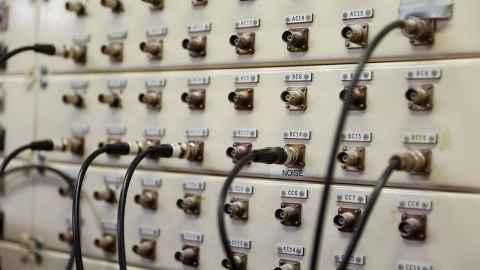My Space: sound and silence
3 June 2025
Bending, stretching and searching for sounds at the Faculty of Engineering's Acoustics and Vibration Research Centre.

In a busy world, many of us crave some silence.
But spending a few minutes in the anechoic chamber at the University’s Acoustics and Vibration Research Centre, perhaps the quietest place in New Zealand, can actually feel a little unsettling.
Every surface of the chamber is lined 1.2 metres deep with foam wedges, including the ground, which has a trampoline-like wire mesh floor suspended above. The chamber is designed to reduce the reflection of sound, and its silence is eerily deep.
And as the centre’s Dr Andrew Hall and Gian Schmid start to explain how the chamber is used to pinpoint exactly where a sound is coming from – the exact location of the whir within a machine, for example – you literally hear the point. Never does a voice sound so connected to its speaker.

The chamber is one of four housed within the research centre, which is part of the Faculty of Engineering and Design. At its heart is a control room (pictured bottom left), dominated on one side by panels for plugging in various cables, giving it the appearance of an old-fashioned phone exchange; loudspeakers, monitors, computers and other acoustic gadgetry occupy the rest of the room.
The centre isn’t flashy, but appearances are deceptive. Andrew, who is a senior lecturer and senior research fellow who specialises in acoustic metamaterials, explains that the facility was designed by renowned architect and acoustics engineer and designer, the late Emeritus Professor Sir Harold Marshall. It was a groundbreaking, state-of-the-art facility for acoustic research and testing when it was built in 1981–82, and it remains so.

“It’s world class,” says Andrew, who currently has a Royal Society research fellowship to investigate materials to reduce noise and improve ventilation for healthier homes.
“I haven’t been to a better one than this anywhere in the world.”
Essentially, it’s a large concrete box, which the control room and acoustic chambers sit within. There are three reverberation chambers; two are adjacent and one sits underneath, and they can be configured to separate or connect via massive steel doors and a drop-down floor.
A massive rotating sound diffuser – a kind of upside-down merry-go-round – hangs from each ceiling of the adjacent reverberation chambers, where all surfaces sit at odd angles to bounce sound around.
Two of the chambers sit on base isolators (the kind of seismic engineering system on which Te Papa is built to withstand earthquakes), which are designed to reduce sound from entering through the ground or between chambers.

As well as operating as a centre for academic research, the facility is used for commercial acoustic testing. Gian, who is the centre’s senior technologist and runs its acoustic testing service, says because the facility is unique in New Zealand it is in high demand. It is used by everyone from the makers of construction materials to drones, to test their products’ acoustic performance.
The anechoic chamber is eerie and impressive, but Andrew says his favourite spaces in the centre are its reverberation chambers.
“When there’s the opportunity to have all three connected, it’s pretty impressive,” says Andrew, who is an accomplished jazz saxophonist. “Especially if you go in there and play the saxophone, hearing how long the sound lasts is just incredible.”
Caitlin Sykes
This article first appeared in the June 2025 issue of UniNews.